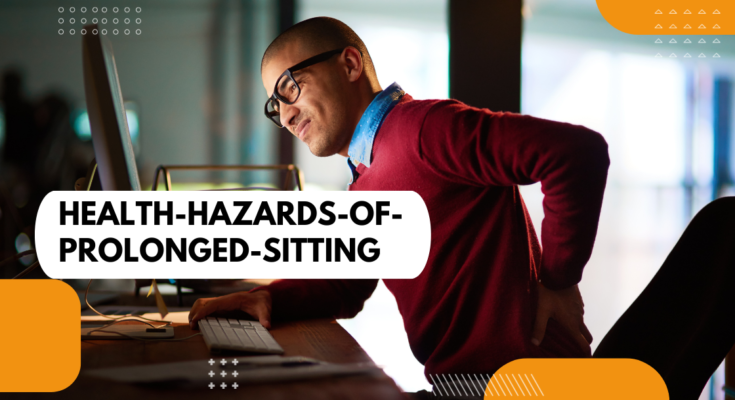
Wellhealthorganic.com:Health-Hazards-of-Prolonged-Sitting
Wellhealthorganic.com:Health-Hazards-of-Prolonged-Sitting Inordinate sitting geste is a threat factor for numerous adverse health issues. This study aimed to survey the frequence of sitting geste and its adverse goods among Iranian office workers.
Thiscross-sectional study included 447 Iranian office workers. The first part surveyed the demographic characteristics and general health of the repliers, while the alternate part contained the Nordic Musculoskeletal Questionnaire( NMQ) to assess symptoms. Wellhealthorganic.com:Health-Hazards-of-Prolonged-Sitting Statistical analyses were performed using the Statistical Package for the Social lores software using Mann- Whitney U and Chi-square tests and multiple logistic retrogression analysis.
Results
The repliers spent an normal of6.29 hours of an 8- hour working shift in a sitting position. The results showed that48.8 of the actors didn’t feel comfortable with their workstations and73.6 felt exhausted during the workday. also,6.3 suffered from hypertension, and11.2 of them reported hyperlipidemia. The results of the NMQ showed that neck(53.5), Wellhealthorganic.com:Health-Hazards-of-Prolonged-Sitting lower reverse(53.2) and shoulder(51.6) symptoms were the most current problem among office workers. Grounded upon a multiple logistic retrogression, only coitus had a significant association with prolonged sitting geste ( odds rate = 3.084). Our results indicated that long sitting times were associated with prostration during the working day, dropped job satisfaction, hypertension, and musculoskeletal complaint symptoms in the shoulders, lower reverse, shanks, and knees of office workers.
Sitting geste had adverse goods on office workers. Active workstations are thus recommended to ameliorate working conditions.
Preface

Ultramodern workplaces have shifted the Wellhealthorganic.com:Health-Hazards-of-Prolonged-Sitting nature of occupations from active to sedentary and promote lengthy sitting geste . One cause of this change is the transition from paper- grounded work to motorized and paperless work( 1).
Office workers are part of a large group of occupations that generally work in a sitting position for important of the day( 2). These people remain in a sitting posture for about two- thirds of their working hours, and their bouts of sitting ages generally last at least 30 twinkles( 3,4).
In 2008, Wellhealthorganic.com:Health-Hazards-of-Prolonged-Sitting about 25 of all United States jobs had a sedentary nature, while this chance was only 15 in 1960( 1). An Australian study revealed that 42 of men and 47 of women spend an normal of6.3 of their 8- hour shifts in sedentary and sitting jobs( 5). Also, in the Netherlands, about 50 of working grown-ups report that they maintain a sitting posture for four or further hours each working day( 6).
Sedentary geste has been defined
Any geste characterized by an energy expenditure of ≤1.5 METs while in a sitting or reclining posture ”( 7). Sedentary Wellhealthorganic.com:Health-Hazards-of-Prolonged-Sitting and sitting geste in office workplaces is a threat factor for cardio- metabolic complaint, type 2 diabetes, rotundity, coronary roadway complaint, musculoskeletal diseases( 8), some types of cancer, and unseasonable death( 9,10).
The results of Church etal. ′ s( 2011) study revealed that the average energy expenditure of individualities while at work declined from 1960 – 2010. This shift in occupational energy expenditure has been associated with a drop of 100 calories per day, which in turn account for as important as 80 of the average Grounded on Atkin and Wannameth ′ s study( 2015), fat and rotundity are major public health problems with an adding frequence worldwide, and are also threat factors for cardiovascular.
The findings of some studies indicated that for each two- hour proliferation in sitting time, the threat of rotundity and Wellhealthorganic.com:Health-Hazards-of-Prolonged-Sitting diabetes increases by 5 and 7, independently( 12). In discrepancy, dragged sitting geste raises the threat of musculoskeletal diseases, especially downward back pain( 13). also, the findings of Gianoudis etal. ′ s study revealed that a lesser overall sitting time is associated with an increased threat of sarcopenia, which climbs by 33 for each one- hour proliferation of sitting( 14). Other studies have shown that sedentary occupations are associated with a advanced threat of developing some types of cancers, similar as colorectal, ovarian, prostate, and endometrial cancer( 15 – 17).
Another outgrowth of a sedentary life is unseasonable death
The World Health Organization( WHO, 2013) estimates that3.2 million people worldwide die precociously each time due to a sedentary life( 18). Studies have shown that people who spend nearly all of their working time in a sitting position have a1.4- times lesser chance of unseasonable death after 12 times than their counterparts who sit for lower time at work( 19).
In discrepancy, an active life improves one ′ s general health and decreases the threat of habitual conditions( 20). It has been reported that active rest bouts between prolonged sitting ages are associated with salutary metabolic biographies in grown-ups and also dropped midriff circumference, body mass indicator( BMI), triglyceride situations, and two- hour tube glucose situations( 21).
lately, health guidelines in Australia( 22) and Britain( 23) have been Wellhealthorganic.com:Health-Hazards-of-Prolonged-Sitting published that recommend grown-ups from 18 – 64 times old drop their diurnal quantum of sitting time. still, in Iran, there aren’t yet proper recommendations for reducing sedentary and sitting actions in office workers. thus, this study aimed to survey the frequence of sitting geste and its adverse effect among office workers of the Shiraz University of Medical lores and recommend results.






